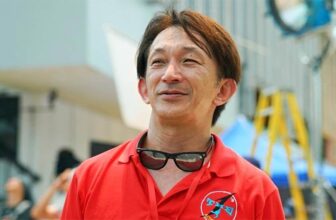
Just take my advice: if you are a respectable girl, as you say you are, don’t walk in Regent Street at night.
This was the advice of a judge to Elizabeth Cass, a respectable woman of perfect character, who was wrongfully arrested for prostitution while out shopping one evening in 1887. The arresting officer is believed to have lied in order to justify her arrest, but this was never proved.
Dr Emelyne Godfrey is an expert on violence and self-defence in the Victoria era. In this talk given last month in Asia House Library, she took Miss Cass’s arrest as a starting point, and explored the development of martial arts training for women – particularly the Suffragettes – in the years that followed.
The case of Miss Cass drew national attention for its unfairness. Women were already scared to go out in the street due to the high levels of violence in Victorian society; and this incident showed that they were not even necessarily safe from the police, who were expected to protect them. At the same time, actresses were starting to speak out about being molested by men in the course of their work. The issue of women’s safety started to become high profile.
Partly because of this intense level of fear, and partly because Britain was obsessed with all things Japanese at that time (a craze known as Japonisme), Jujitsu and other martial arts started to become respectable exercise activities for ladies, as popularised by early female instructors such as Emily Diana Watts.
The form that Watts taught however was focused more on improving health, beauty and deportment than actually teaching effective self-defence. It typically didn’t include partner practice, and focused heavily on the Judo practice of tandoku renshū – solo practice of the movements to improve coordination. Ladies also trained with Indian Clubs in a safe and genteel way; these weapons were later appropriated by the Suffragettes as part of their armoury.
At the same time, society was so violent, that violence was generally seen as an acceptable way to resolve disputes. Duelling was made illegal, but boxing soon started to take its place. Women took to carrying specific “feminine” weapons on their person, such as giant hat pins up to nine inches long or even longer; or the Eastern-inspired dagger-fan.
By way of historical context, Emelyne also talked about Bartitsu – a Victorian British blend of jujitsu and boxing, and arguably the first form of modern MMA. It was designed for “gentlemen” to use against “hooligans”, and made use of typical objects the gentlemen might carry – walking sticks, capes and so on – never guns or knives.
Emelyne explained that there were a number of women’s groups campaigning for equal rights at that time. Many went under the more general term Suffragists, and operated in a more peaceful way which is less well-known about nowadays.
The Suffragettes however (a term coined by the Daily Mail) tended towards more aggressive, militant activism – Emmeline Pankhurst is said to have espoused chaos and violence, and described herself as a hooligan. Emelyne explained that modern academic historians often now class these women as terrorists, rather than the plucky heroines we tend to imagine.
In November 1910, the first attempt at a Conciliation Bill fell through. This bill would have allowed wealthy women in Britain and Ireland to vote. The suffragettes protested violently, in an event now known as Black Friday, and at least 200 of them were assaulted and manhandled by the police. This is believed to be the first time the police had used violence against the Suffragettes, and it marked a turning point.
Many women were by now already studying jujutsu as a fashionable form of self-defence. The focus was still on training for “ladylike” health and beauty reasons however. The manager of one famous male Japanese practitioner is quoted as saying:
“Ju-jitsu is particularly adapted for ladies for several reasons. In the first place, no muscular strength is required, for it is all a question of ‘knack’ and quickness. In the second the science, apart from its usefulness as a means of self-defence, induces grace of carriage and develops the figure. You see, to be a competent ju-jitsuist you must hold yourself upright. Whereas, in other styles of wrestling, one has to adopt a crouching attitude, which contracts the chest and makes the figure ugly.”
However, following Black Friday, Edith Garrud, one of the first female professional martial arts instructors in the Western world, opened her own dojo, and started to train the Suffragettes in earnest. Although Edith’s dojo presented as a respectable training hall for ladies, it was in fact a hub and refuge for militant campaigners. As well as training the women to fight effectively (as opposed to training to improve their health and beauty), she freely allowed women to hide there after violent incidents (there were hiding places for weapons under the mats), in order to escape arrest.
In time, Edith became the trainer of a highly effective 30-strong female-only protection unit known as “The Bodyguard”, the “Jiujitsuffragettes” or the “Amazons”. This unit was particularly used to protect Emmeline Pankhurst and other suffragettes from re-arrest after the introduction of the so-called “Cat and Mouse” Act of 1913, whereby women on hunger strike could be released from prison, and rearrested when they recovered. You can read more about the Bodyguard’s activities here. Little is known of the individual members of the unit now; Emelyne is currently researching and piecing together what little available information exists.
The talk gave a fascinating glimpse into how British women started to engage in the martial arts in the late nineteenth and early twentieth centuries. Emelyne handed round examples of the weapons these women used; and vividly conveyed the powerful, disorientating impact of “ladies” suddenly using violence in this way.
You can find out more on Emelyne’s own website, or by reading her book: Femininity, Crime and Self-Defence in Victorian Literature and Society; From Dagger-Fans to Suffragettes









🙂 Great article – thanks! An interesting insight into the Victorian world…